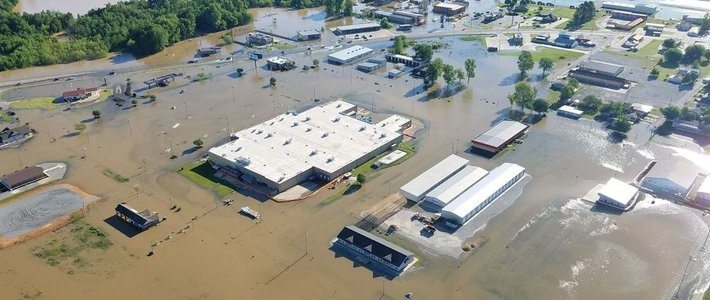Flooding in Northeast Arkansas could have more than $300 million economic impact on agriculture industry
by May 25, 2017 12:00 pm 603 views

The University of Arkansas Division of Agriculture released a report last week that indicated the damage done to the agriculture industry in the state due to floods in Northeast Arkansas could top $175 million.
That estimate is likely to grow significantly in the coming weeks and could approach the estimated $335 million lost during the 2011 floods in the same region, rice agronomist Dr. Jarrod Hardke told Talk Business & Politics.
“I really feel like those numbers are going to climb,” he said. “Everything points to an upward trend as more data is processed.”
The preliminary report estimates the number of acres lost or damaged, and the effects on yields. It doesn’t take into account infrastructure, equipment, preventive planning and other losses, Hardke said. Those could include costs such as replacing tractors, grain bins, barns, sheds, irrigation systems, and others. In the coming weeks, those numbers should be tabulated.
When the Black River at Pocahontas overwhelmed an earthen levee system, a wall of water blanketed the countryside. Floods along the river and others damaged or destroyed about 970,000 farmland acres. Insurance regulations require farmers to have rice replanted by the extended deadline of June 9.
Gov. Asa Hutchinson, U.S. Rep. Rick Crawford, R-Jonesboro, and others have sent letters to U.S. Agriculture Secretary Sonny Perdue asking for the deadline to be extended. Hardke said he’s sure it won’t happen. Those deadlines are set in concert with paid insurance policies and it would be nearly impossible to change them at this point, he said.
At least 21 counties statewide received damage. Clay, Craighead, Crittenden, Cross, Desha, Greene, Independence, Jackson, Jefferson, Lawrence, Lee, Lonoke, Mississippi, Phillips, Poinsett, Prairie, Pulaski, Randolph, St. Francis, White and Woodruff suffered losses.
Poinsett County received the most damage with 194,900 acres lost. Greene County had 138,000 acres affected, while Prairie County, 125,000 acres. Lawrence County had 80,000 acres and Randolph had 60,000 acres.
Rice was the hardest hit crop with 181,450. Soybeans losses tallied 121,800 acres. At least 40,150 corn acres were lost. Cotton was at 13,000 acres, while wheat was at 4,250 acres, and at least 1,000 sorghum acres have been lost. Hardke said these numbers will likely rise, as well.
Hardke still thinks the state could harvest 1 million rice acres despite the losses. It could be the smallest rice crop in at least 30 years, however. Arkansas farmers planted an estimated 1.2 million rice acres this spring. One of the key differences between the last epic flood to hit the state in 2011 and now is the timing, Hardke said. About 45% of the rice crop was in the ground when the levee system in Pocahontas ruptured six years ago, and widespread flooding occurred throughout the Mississippi Delta Region. This year, 89% of the rice crop has already been planted, he said.
Rice crops were already expected to be much lower this year in the Natural State. Low prices and high inventories compelled farmers to plant 3.5 million soybean acres this spring, the most in the state since 1998. Hardke said replanting rice or switching to soybeans could be tricky, and it might not be cost effective.
Finding replant seeds for either will be difficult, he added. The window to plant a viable rice crop is closing. Rice has to be in the ground no later than the first week in June, and even then, the yields will be much lower, Hardke said. Rice planted in early April will produce an optimal yield for the majority of farmers. If it’s planted in early May, research has shown the yield can drop up to 15%. Rice planted in early June can produce yields 30% less than optimal.
It still isn’t clear what federal aid will be given to farmers. Assessments at the state level are ongoing, according to officials. Once the assessments are complete, the information will be sent to Perdue.
